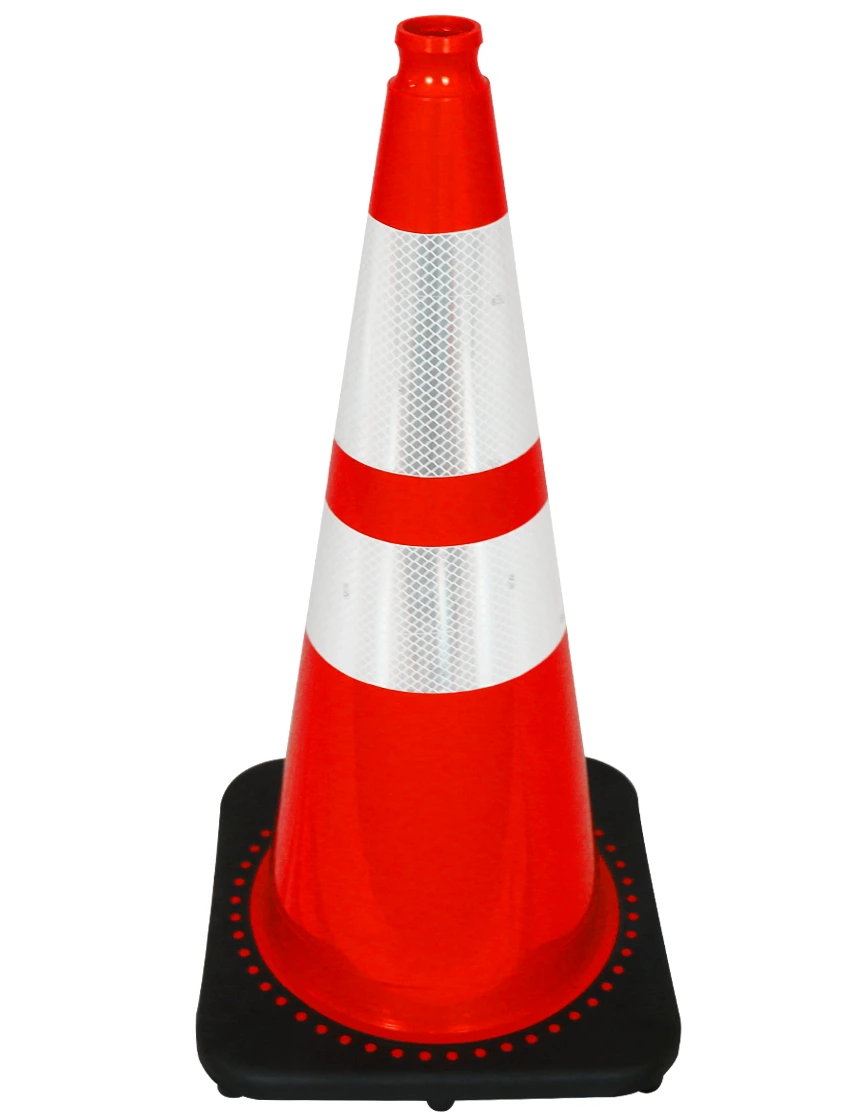28″ vs 36″ Traffic Cones – When (and Why) to Use Each Size
Traffic Safety Store1. The Regulatory Baseline (MUTCD 11th Edition)
According to the MUTCD 11th Edition (Section 6F.65):- Daytime & low-speed roadways – minimum height 18 inches. Low-speed is typically considered roadways with speed limits of 40 mph or less.
- Nighttime use, or roadways with a speed limit of 45 mph or higher – minimum height 28 inches.
- Freeways, other high-speed highways, or when more conspicuous guidance is needed – minimum height 28 inches.
- Cones more than 36 inches in height require horizontal, circumferential, alternating orange and white retroreflective stripes that are 4 to 6 inches wide, with a minimum of two orange and two white stripes (top stripe orange).
Retroreflectivity Requirements
For maximum visibility, especially at night, cones must be retroreflectorized:- Cones less than 28 inches: At least one 6-inch wide retroreflective band placed a minimum of 3 inches from the top.
- Cones 28 to 36 inches: A 6-inch wide white band located 3 to 4 inches from the top, and an additional 4-inch wide white band located approximately 2 inches below the 6-inch band.
- Cones more than 36 inches: As noted above, alternating orange and white stripes.
2. Why Some Agencies Prefer 36 Inches
While the MUTCD sets the minimum at 28 inches for high-speed and nighttime conditions, many agencies and projects opt for 36-inch cones for enhanced visibility, stability, and compliance with stricter local guidelines. For example, North Carolina DOT mandates 36-inch cones on freeways and interstates. Typical reasons include:| Factor | 28″ Cone | 36″ Cone |
|---|---|---|
| Visibility from driver eye-height (e.g., SUV or truck) | May be obscured by vehicle hood or glare | Better line-of-sight above most vehicle hoods |
| Retroreflective surface area | Standard two bands (6″ + 4″ white) | Larger overall surface; can accommodate optional additional banding |
| Wind and stability | Lighter weight—may require ballast rings to prevent tipping | Heavier base provides natural resistance to wind and minor impacts |
| Compliance margin | Meets MUTCD minimum for high-speed/nighttime | Exceeds minimum; often preferred or required by state DOTs for freeways |
3. When a 28-Inch Cone Is the Right Tool
- Urban streets with speeds ≤ 40 mph – suitable for lane closures, utility work, and short tapers.
- Daytime operations on low-volume or two-lane roads – lighter and easier to deploy for mobile crews.
- Parking lots, school zones, or special events – portable yet tall enough to guide pedestrians and vehicles.
- Night work on low-speed roads with proper retroreflective bands – must include the required two-band pattern (6″ + 4″ white).
4. When to Deploy 36-Inch Cones
- Speeds ≥ 45 mph (freeways, expressways, multilane arterials) – for better visibility and stability.
- Nighttime work on high-volume or high-speed roads – exceeds minimum requirements for safety.
- Long-term or multi-day closures – heavier design reduces need for frequent adjustments.
- Areas with heavy truck traffic, blind curves, or crests – provides extra conspicuity.
- Projects with stricter local mandates – verify with your state DOT (e.g., NCDOT mandates 36″ for freeways; Caltrans recommends for urban freeways).
5. Quick Decision Flow
- Assess posted speed limit:
- < 45 mph → consider 28″ as starting point.
- ≥ 45 mph → default to 36″ for enhanced safety.
- Day or night operations?
- Night work requires at least 28″; prefer 36″ on high-speed roads for better visibility.
- Job duration and exposure:
- Short, mobile, low-speed daytime tasks → 28″.
- Stationary, multi-day closures on busy roads → 36″.
- Local specs override MUTCD minimums: Always review state DOT guidelines and contract documents.
6. Final Takeaways
Cone height is a critical safety factor, not just a preference. A 28-inch cone satisfies the federal minimum for high-speed or nighttime work, but a 36-inch cone offers superior visibility, stability, and alignment with many agency preferences. Combine appropriate cone height with correct retroreflective banding and spacing (per MUTCD Tables 6B-3 & 6B-4) to create a clear, consistent guide for drivers. When uncertain, opt for larger sizes—the added cost is often offset by lower risk and maintenance needs.Learn more about Safety Vests, Road Flares, and Traffic Cones at TrafficSafetyStore.com – for all your traffic safety needs.
Stay Safe. Stay Compliant. Choose Traffic Safety Store.

Orange 36" 10.0 Lb. Traffic Cone with Black Base
- 14" x 14" base
- Approx. 10.0 lbs. each
- Two 'recesses' molded into cone to protect reflective collars when stacked
Quick Facts:
- 36" tall, 14"x14" base, Bright Orange
- 10 lbs weight
- Safety Standards - MUTCD; NCHRP-350 crashworthy approval
- Free Shipping on orders of 385 cones or more
- call for details 800-429-9030

Orange 28" 7.0 Lb. Traffic Cone with Black Base
- 14" x 14" base
- Approx. 7.0 lbs. each
Quick Facts:
- 28" tall, 14"x14" base
- 7 lbs weight
- JBC Part No. RS70032CT3M64
- Safety Standards - MUTCD; NCHRP-350 crashworthy approval
- Free Shipping on orders of 465 cones or more
- call for details 800-429-9030
